Dynamics of Paddy Field Patterns in Response to Urbanization: A Case Study of the Hang-Jia-Hu Plain
Abstract
:1. Introduction
2. Materials and Methods
2.1. Study Area
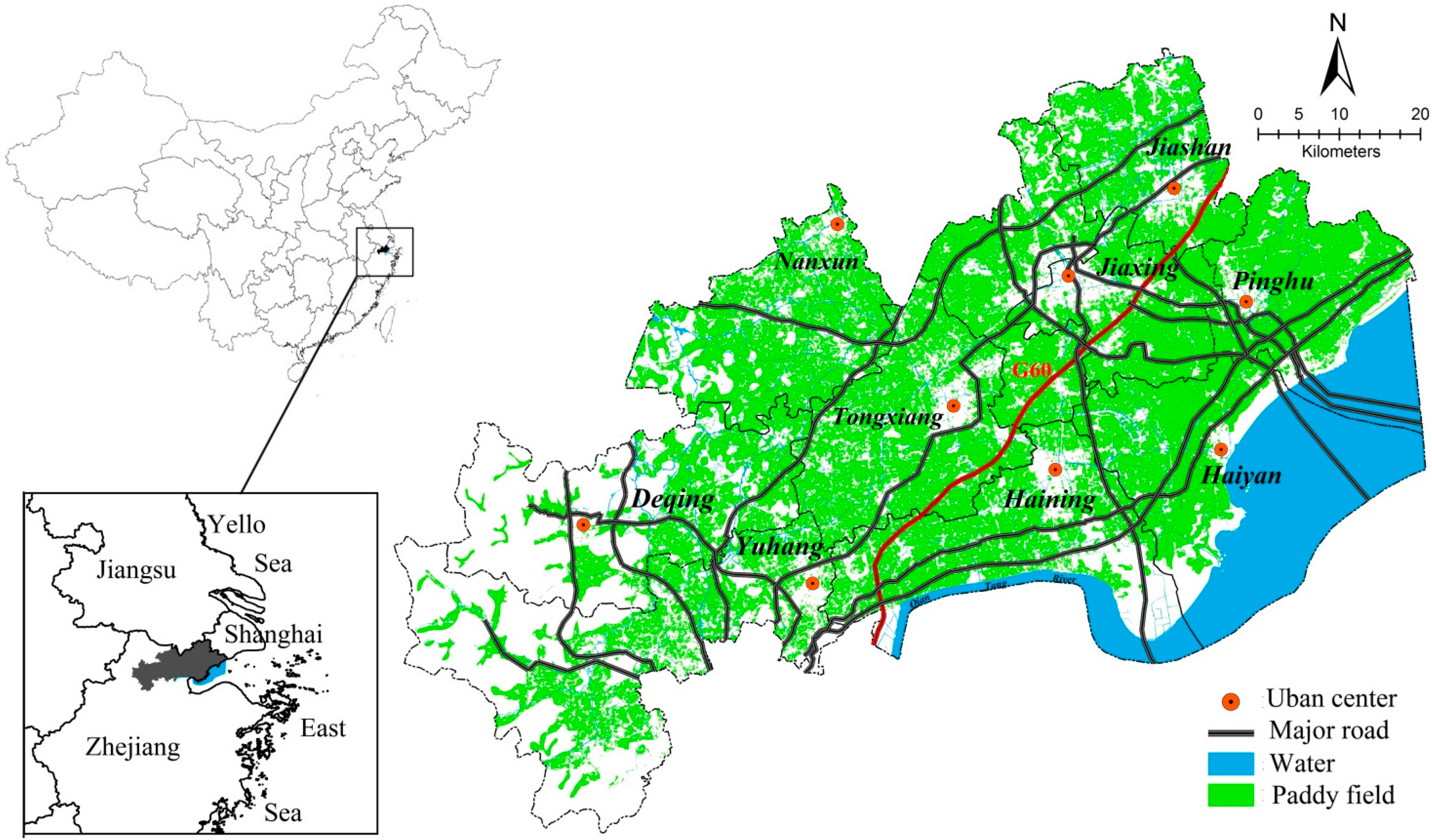
2.2. Data Sources
2.3. Average Annual Rate of Urbanization Indicators
2.4. Spatiotemporal Analysis of the Urbanization Process
2.5. Grading Paddy Field Quality
2.6. Dynamic Changes of Paddy Fields during the Urbanization Process
3. Results
3.1. General Process of Urbanization
| 1980 | 1990 | 2000 | 2010 | Change Rate between 1980 and 1990 (%) | Change Rate between 1990 and 2000 (%) | Change Rate between 2000 and 2010 (%) | |
|---|---|---|---|---|---|---|---|
| Gross domestic product (billion yuan) | 2.74 | 12.44 | 77.07 | 339.78 | 18.32 | 22.49 | 23.20 |
| Total population (million) | 4.12 | 4.46 | 4.55 | 5.26 | 1.43 | 0.23 | 1.48 |
| Urban area (km2) | 435.46 | 501.02 | 915.40 | 1616.22 | 1.57 | 6.93 | 6.52 |

3.2. Dynamic Changes of Paddy Fields
3.2.1. Quality Grades of Paddy Fields in the Hang-Jia-Hu Plain
| Level I | Level II | Level III | ||||
|---|---|---|---|---|---|---|
| Area ( km2) | (% of total) | Area (km2) | (% of total) | Area ( km2) | (% of total) | |
| Zhejiang Province | 6375.96 | 31.40 | 11144.04 | 54.90 | 2784.13 | 13.70 |
| Hang-Jia-Hu Plain | 3009.31 | 96.17 | 123.24 | 3.93 | 0.00 | 0.00 |

3.2.2. Dynamic Changes of Paddy Fields in Response to Urbanization
| Period | New Urban Area (km2) | New urban Area Converted Form Paddy Fields | ||
|---|---|---|---|---|
| Area (km2) | (% of New Urban Area) | |||
| Yuhang | T1 | 2.57 | 2.07 | 80.54 |
| T2 | 50.67 | 35.92 | 70.89 | |
| T3 | 151.54 | 120.07 | 79.23 | |
| Deqing | T1 | 1.24 | 0.83 | 66.94 |
| T2 | 20.01 | 12.81 | 64.02 | |
| T3 | 66.63 | 49.18 | 73.81 | |
| Nanxun | T1 | 0.98 | 0.55 | 56.12 |
| T2 | 19.89 | 17.42 | 87.58 | |
| T3 | 95.13 | 87.96 | 92.46 | |
| Haining | T1 | 6.67 | 4.75 | 71.21 |
| T2 | 82.23 | 69.99 | 85.11 | |
| T3 | 79.46 | 64.75 | 81.49 | |
| Haiyan | T1 | 7.51 | 4.79 | 63.78 |
| T2 | 24.53 | 20.44 | 83.33 | |
| T3 | 25.56 | 23.07 | 90.26 | |
| Jiashan | T1 | 15.29 | 14.54 | 95.09 |
| T2 | 39.01 | 38.27 | 98.10 | |
| T3 | 40.09 | 40.77 | 96.86 | |
| Pinghu | T1 | 15.52 | 14.06 | 90.59 |
| T2 | 46.47 | 44.26 | 95.24 | |
| T3 | 26.41 | 23.37 | 88.49 | |
| Tongxiang | T1 | 1.21 | 0.98 | 80.99 |
| T2 | 31.27 | 30.29 | 96.87 | |
| T3 | 126.24 | 122.38 | 96.94 | |
| Jiaxing | T1 | 14.57 | 14.04 | 96.36 |
| T2 | 100.30 | 98.80 | 98.50 | |
| T3 | 87.76 | 86.33 | 98.37 | |

3.3. Spatiotemporal Dynamic Patterns of Urban Growth in the Hang-Jia-Hu Plain

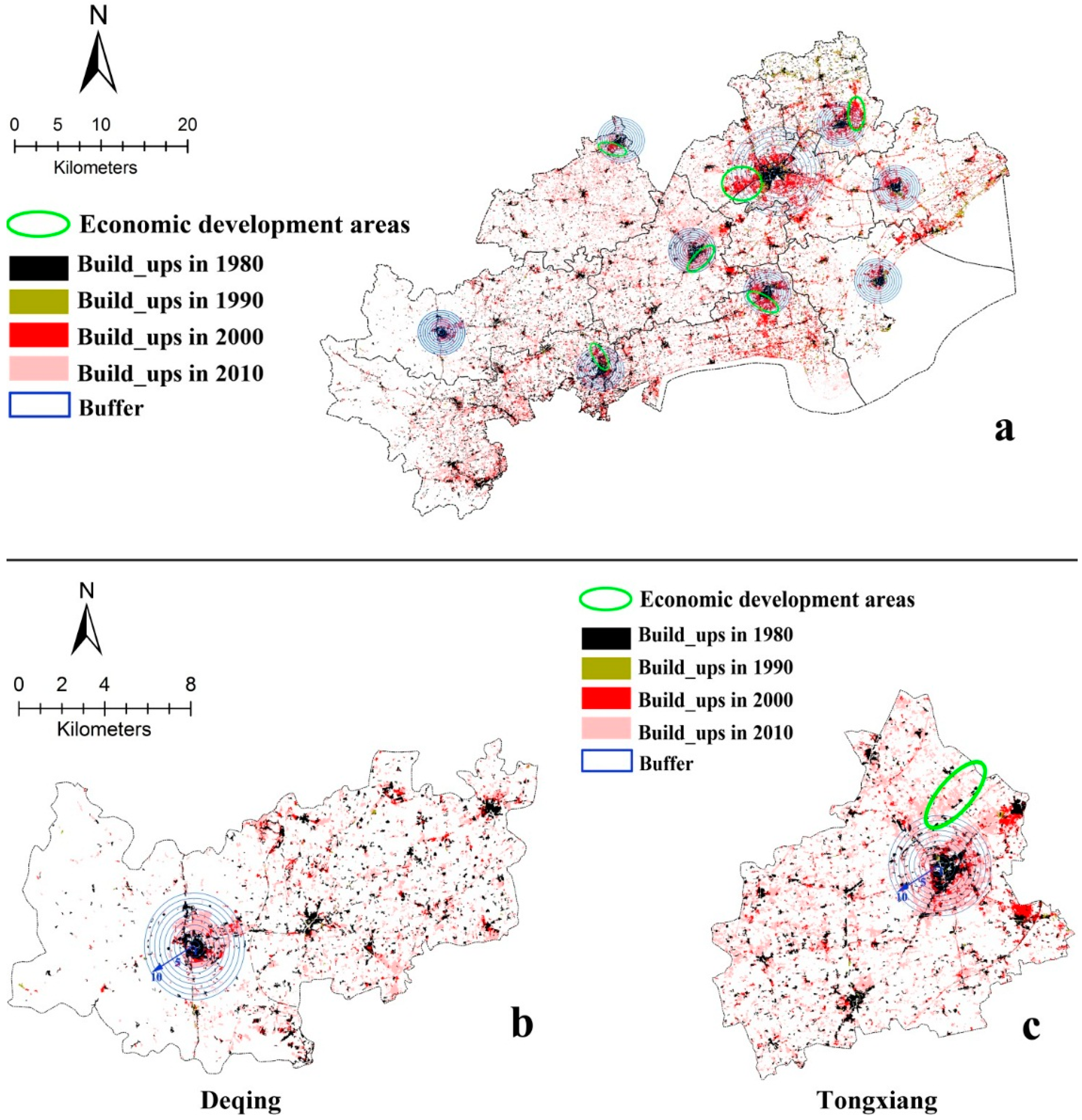
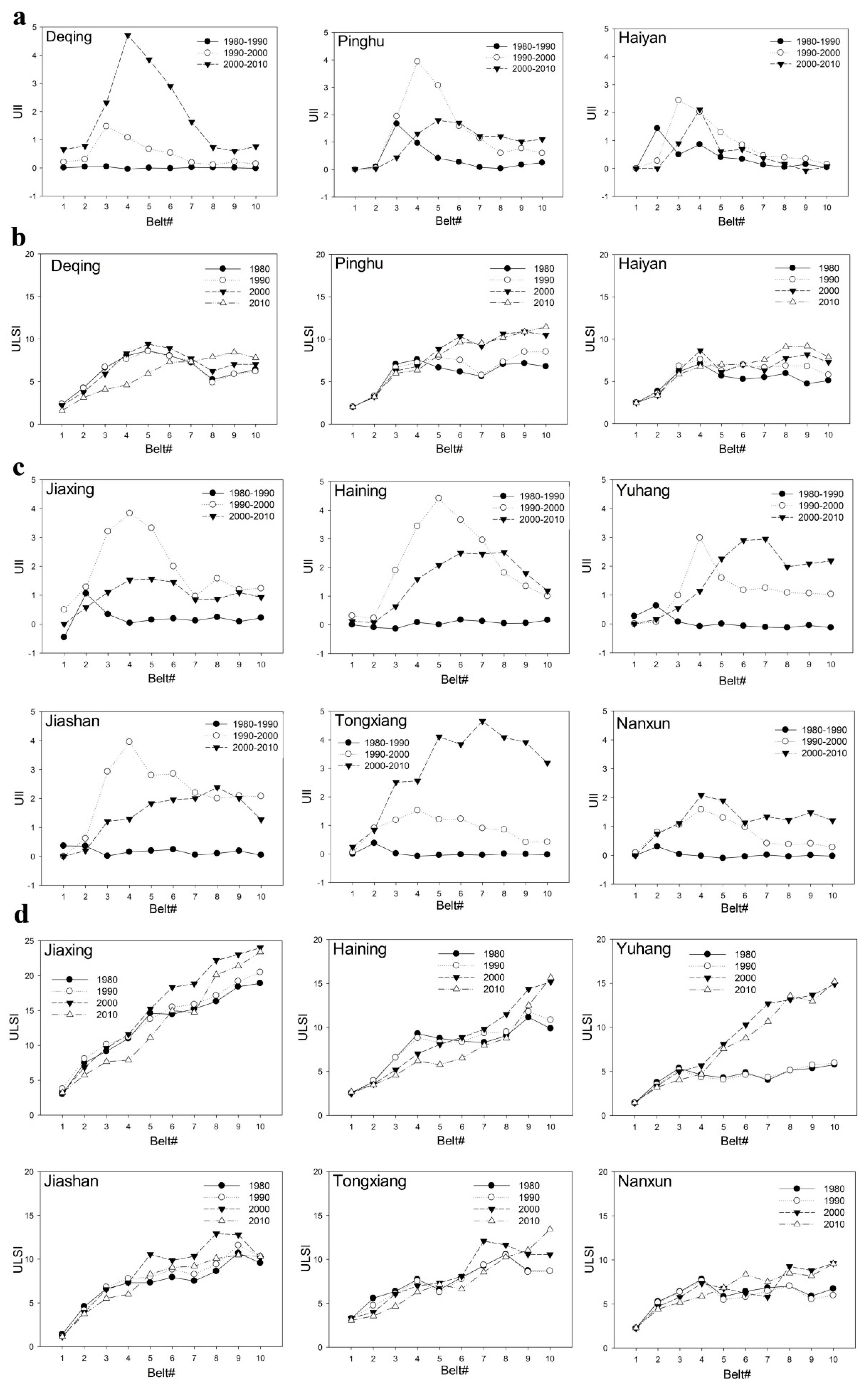
3.4. Spatiotemporal Dynamic Patterns of Paddy Fields in Response to Urban Growth
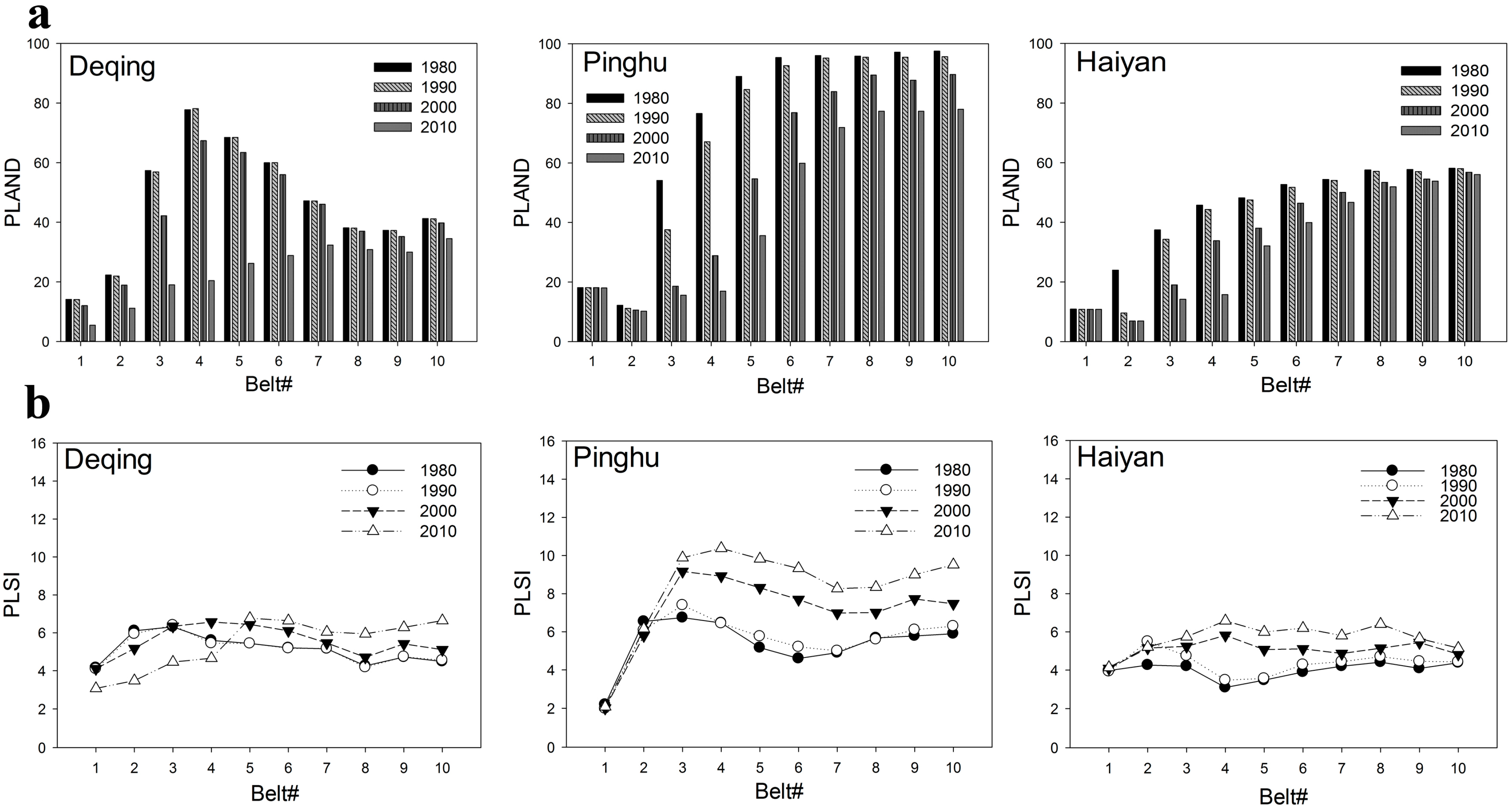
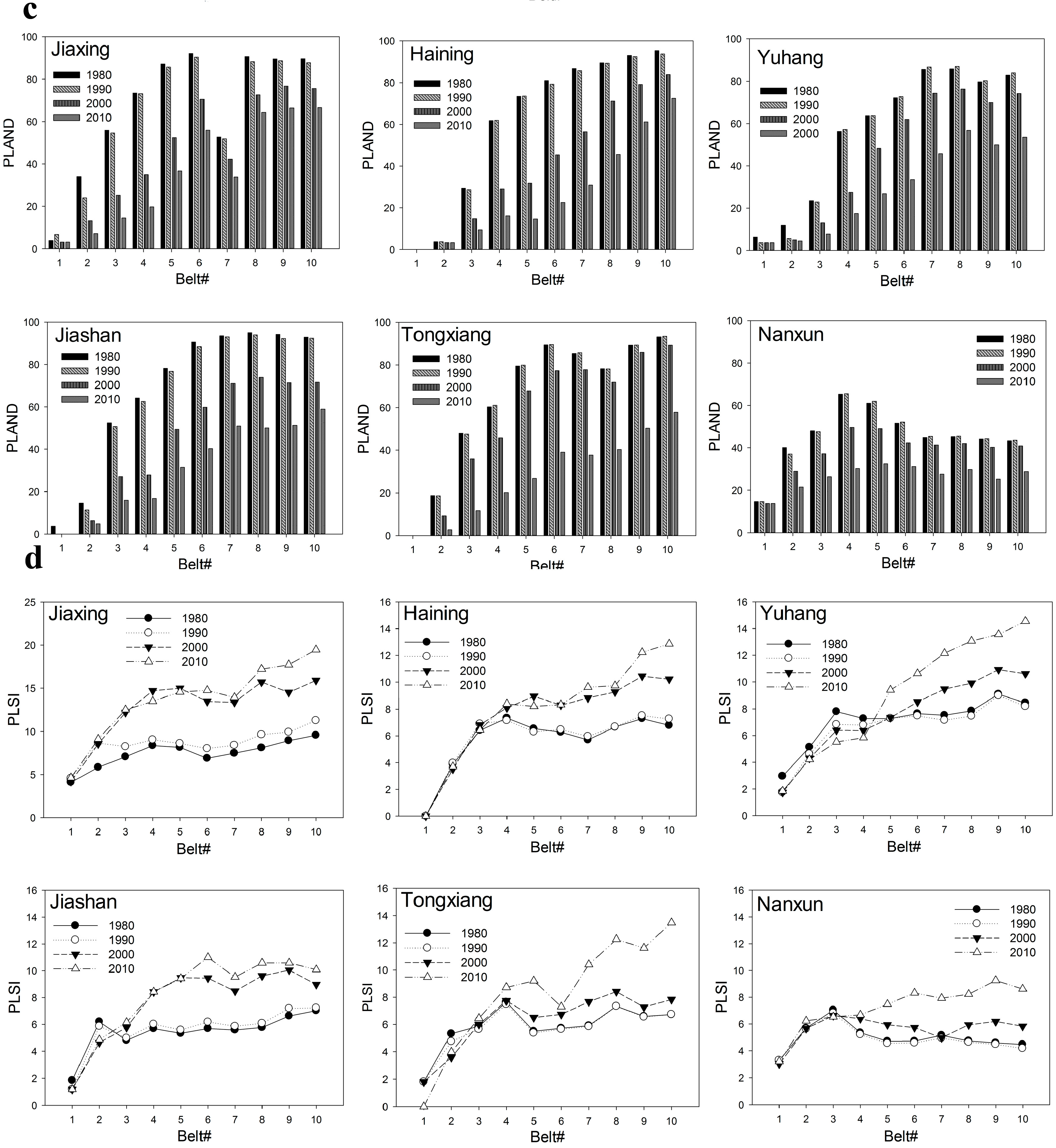
4. Discussions
4.1. Driving Forces of Urban Expansion


4.2. Spatial Features of Urban Growth and Their Impacts on Paddy Field Patterns
4.3. Future Implications for Sustainable Development in the Hang-Jia-Hu Plain

5. Conclusions
Acknowledgments
Author Contributions
Conflicts of Interest
References
- Cheng, J.; Masser, I. Urban growth pattern modeling: A case study of Wuhan City PR China. Landsc. Urban Plan. 2003, 62, 199–217. [Google Scholar] [CrossRef]
- Tian, G.; Liu, J.; Xie, Y.; Yang, Z.; Zhuang, D.; Niu, Z. Analysis of spatio-temporal dynamic pattern and driving forces of urban land in China in 1990s using TM images and GIS. Cities 2005, 22, 400–410. [Google Scholar] [CrossRef]
- Luo, J.; Wei, Y.H.D. Modeling spatial variations of urban growth patterns in Chinese cities: The case of Nanjing. Landsc. Urban Plan. 2009, 91, 51–64. [Google Scholar] [CrossRef]
- Chen, M.; Liu, W.; Tao, X. Evolution and assessment on China’s urbanization1960–2010: Under-urbanization or over-urbanization? Habitat Int. 2013, 38, 25–33. [Google Scholar] [CrossRef]
- Grimm, N.B.; Faeth, S.H.; Golubiewski, N.E.; Redman, C.L.; Wu, J.G.; Bai, X.M.; Briggs, J.M. Global change and the ecology of cities. Science 2008, 319, 756–760. [Google Scholar] [CrossRef] [PubMed]
- Grimm, N.B.; Grove, J.M.; Pickett, S.T.; Redman, C.L. Integrated approaches to long-term studies of urban ecological systems: Urban ecological systems present multiple challenges to ecologists-pervasive human impact and extreme heterogeneity of cities, and the need to integrate social and ecological approaches, concepts, and theory. Bioscience 2000, 50, 571–584. [Google Scholar]
- Tan, P.Y.; Abdul Hamid, A.R.B. Urban ecological research in Singapore and its relevance to the advancement of urban ecology and sustainability. Landsc. Urban Plan. 2014, 125, 271–289. [Google Scholar] [CrossRef]
- Liu, J.Y.; Liu, M.L.; Tian, H.Q.; Zhuang, D.F.; Zhang, Z.X.; Zhang, W.; Tang, X.M.; Deng, X.Z. Spatial and temporal patterns of China’s cropland during 1990–2000: An analysis based on Landsat TM data. Remote Sens. Environ. 2005, 98, 442–456. [Google Scholar] [CrossRef]
- Natuhara, Y. Ecosystem services by paddy fields as substitutes of natural wetlands in Japan. Ecol. Eng. 2013, 56, 97–106. [Google Scholar] [CrossRef]
- Lennartza, B.; Hornb, R.; Duttmannc, R.; Gerked, H.H.; Tippköttere, R.; Eickhorste, T.; Janssen, I.; Janssen, M.; Ruth, B.; Sander, T.; et al. Ecological safe management of terraced rice paddy landscapes. Soil. Till. Res. 2009, 102, 179–192. [Google Scholar] [CrossRef]
- Olarieta, J.R.; Rodríguez-Valle, F.L.; Tello, E. Preserving and destroying soils, transforming landscapes: Soils and land-use changes in the Vallès County (Catalunya, Spain) 1853–2004. Land Use Policy 2008, 25, 474–484. [Google Scholar] [CrossRef]
- Su, S.; Jiang, Z.; Zhang, Q.; Zhang, Y. Transformation of agricultural landscapes under rapid urbanization: A threat to sustainability in Hang-Jia-Hu region, China. Appl. Geogr. 2011, 31, 439–449. [Google Scholar] [CrossRef]
- Xiao, R.; Su, S.; Zhang, Z.; Jiang, D.; Wang, J. Local spatial modeling of paddy soil landscape patterns in response to urbanization across the urban agglomeration around Hangzhou Bay, China. Appl. Geog. 2013, 39, 158–171. [Google Scholar] [CrossRef]
- Sun, X.Z.; Zhou, H.L.; Xie, G.D. Ecological Services and Their Values of Chinese Agroecosystem. China Popul. Resour. Environ. 2007, 17, 55–60. (In Chinese) [Google Scholar]
- Tan, M.; Li, X.; Xie, H.; Lu, C. Urban land expansion and arable land loss in China—A case study of Beijing-Tianjin-Hebei region. Land Use Policy 2005, 22, 187–196. [Google Scholar] [CrossRef]
- Cao, G.; Feng, C.; Tao, R. Local “land finance” in China’s urban expansion: Challenges and solutions. China World Econ. 2008, 16, 19–30. [Google Scholar] [CrossRef]
- Jiang, X.C. Urbanization in China on WTO backgrounds. Urban Stud. 2003, 10, 23–34. [Google Scholar]
- Imhoff, M.L.; Lawrence, W.T.; Elvidge, C.D.; Paul, T.; Levine, E.; Prevalsky, M.; Brown, V. Using nighttime DMSP/OLS images of city lights to estimate the impact of urban land use on soil resources in the U.S. Remote Sens. Environ. 1997, 59, 105–117. [Google Scholar] [CrossRef]
- Long, H.; Liu, Y.; Wu, X.; Dong, G. Spatio-temporal dynamic patterns of farmland and rural settlements in Su-Xi-Chang region: Implications for building a new countryside in coastal China. Land Use Policy 2009, 26, 322–333. [Google Scholar] [CrossRef]
- Hu, X.H.; David, D.K. The emergence of affluent in Beijing: Residential social stratification in China’s capital city. Urban Geogr. 2001, 22, 54–77. [Google Scholar] [CrossRef]
- Ding, C. Policy and praxis of land acquisition in china. Land Use Policy 2007, 24, 1–13. [Google Scholar] [CrossRef]
- Liu, S.; Zhang, P.; Lo, K. Urbanization in remote areas: A case study of the Heilongjiang reclamation area, northeast China. Habitat Int. 2014, 42, 103–110. [Google Scholar] [CrossRef]
- Deng, J.S.; Wang, K.; Hong, Y.; Qi, J.G. Spatio-temporal dynamics and evolution of land use change and landscape pattern in response to rapid urbanization. Landsc. Urban Plan. 2009, 92, 187–198. [Google Scholar] [CrossRef]
- Su, S.; Ma, X.; Xiao, R. Agricultural landscape pattern changes in response to urbanization at ecoregional scale. Ecol. Indic. 2014, 40, 10–18. [Google Scholar] [CrossRef]
- Luck, M.; Wu, J. A gradient analysis of urban landscape pattern: A case study from the Phoenix metropolitan region, Arizona, USA. Landsc. Ecol. 2002, 17, 327–339. [Google Scholar] [CrossRef]
- McDonnell, M.J.; Hahs, A.K. The use of gradient analysis studies in advancing our understanding of the ecology of urbanizing landscapes: Current status and future directions. Landsc. Ecol. 2008, 23, 1143–1155. [Google Scholar] [CrossRef]
- Houghton, R.A.; Hackler, J.L. Sources and sinks of carbon from land-use change in China. Glob. Biogeochem. Cycl. 2003. [Google Scholar] [CrossRef]
- Seto, K.C.; Fragkias, M. Quantifying spatiotemporal patterns of urban land-use change in four cities of China with time series landscape metrics. Landsc. Ecol. 2005, 20, 871–888. [Google Scholar] [CrossRef]
- Shen, W.J.; Wu, J.G.; Grimm, N.B.; Hope, D. Effects of urbanization-induced environmental changes on ecosystem functioning in the Phoenix metropolitan region, USA. Ecosystems 2008, 11, 138–155. [Google Scholar] [CrossRef]
- Tate, C.M.; Cuffney, T.F.; Mcmahon, G.; Giddings, E.M.P.; Coles, J.F.; Zappia, H. Use of an urban intensity index to assess urban effects on streams in three contrasting environmental settings. Am. Fish. Soc. Symp. 2005, 47, 291–315. [Google Scholar]
- Su, S.; Xiao, R.; Zhang, Y. Multi-scale analysis of spatially varying relationships between agricultural landscape patterns and urbanization using geographically weighted regression. Appl. Geogr. 2012, 32, 360–375. [Google Scholar] [CrossRef]
- Li, J.D.; Deng, J.S.; Wang, K.; Li, J.; Huang, T.; Lin, Y.; Yu, H.Y. Spatiotemporal Patterns of Urbanization in a Developed Region. Sustainability 2014, 6, 4042–4058. [Google Scholar] [CrossRef]
- Zhou, X.L.; Wang, Y.C. Spatial–temporal dynamics of urban green space in response to rapid urbanization and greening policies. Landsc. Urban Plan. 2011, 100, 268–277. [Google Scholar] [CrossRef]
- Zhang, Y.H.; Ma, Q. Investigation and Evaluation of Chinese Cultivated Land Quality (Zhejiang Section); China Land Press: Beijing, China, 2010; pp. 116–126. (In Chinese) [Google Scholar]
- Pan, X.Z.; Zhao, Q.G. Measurement of urbanization process and the paddy soil loss in Yixing city, China between 1949 and 2000. Catena 2007, 69, 65–73. [Google Scholar] [CrossRef]
- Su, S.; Zhang, Q.; Zhang, Z.; Zhi, J.; Wu, J. Rural settlement expansion and paddy soil loss across an ex-urbanizing watershed in eastern coastal china during market transition. Reg. Environ. Chang. 2011, 11, 651–662. [Google Scholar] [CrossRef]
- Liu, Y.L.; Luo, T.; Liu, Z.Q.; Kong, X.S.; Li, J.W.; Tan, R.H. A comparative analysis of urban and rural construction land use change and driving forces: Implications for urban–rural coordination development in Wuhan, Central China. Habitat Int. 2015, 47, 113–125. [Google Scholar] [CrossRef]
- Yeh, A.; Wu, F. Internal structure of Chinese cities in the midst of economic reform. Urban Geogr. 1995, 16, 521–554. [Google Scholar]
- Hu, X.; Wang, W.; Sheng, H. Urban traffic flow prediction with variable cell transmission model. J. Transp. Syst. Eng. Inf. Technol. 2010, 10, 73–78. [Google Scholar] [CrossRef]
- Tian, G.J.; Wu, J.G. Comparing urbanization patterns in Guangzhou of China and Phoenix of the USA: The influences of roads and rivers. Ecol. Indic. 2015, 51, 23–30. [Google Scholar] [CrossRef]
- Li, X.W.; Fang, J.Y.; Piao, S.L. The comparison of spatial characteristics in urban landuse growth among the central and sub-cities in Shanghai Region. Geogr. Res. 2003, 22, 769–779. [Google Scholar]
- Tian, G.J.; Jiang, J.; Yang, Z.F.; Zhang, Y.Q. The urban growth, size distribution and spatio-temporal dynamic pattern of the Yangtze River Delta megalopolitan region, China. Ecol. Model. 2011, 222, 865–878. [Google Scholar] [CrossRef]
- Shoyama, K.; Braimoh, A.K. Analyzing about sixty years of land-cover change and associated landscape fragmentation in Shiretoko Peninsula, Northern Japan. Landsc. Urban Plan. 2011, 101, 22–29. [Google Scholar] [CrossRef]
- Pijanowski, B.C.; Ray, D.K. Rates and patterns of land use change in the Upper Great Lakes States, USA: A framework for spatial temporal analysis. Landsc. Urban Plan. 2011, 102, 102–116. [Google Scholar] [CrossRef]
- IRRI. China. Available online: http://irri.org/our-work/locations/china (accessed on 20 August 2015).
- Zhang, X.; Chen, J.; Tan, M.; Sun, Y. Assessing the impact of urban sprawl on soil resources of Nanjing city using satellite images and digital soil databases. Catena 2007, 69, 16–30. [Google Scholar] [CrossRef]
- Ewing, R.H. Characteristics, causes, and effects of sprawl: A literature review. Environ. Urban Stud. 1994, 21, 519–535. [Google Scholar]
- Thompson, A.W.; Prokopy, L.S. Tracking urban sprawl: Using spatial data to inform farmland preservation policy. Land Use Policy 2009, 26, 194–202. [Google Scholar] [CrossRef]
- Markus, A.; Djadja, S. Assessing soil properties and tidal behaviors as a strategy to avoid environmental degradation in developing new paddy fields in tidal areas. Agric. Ecosyst. Environ. 2013, 181, 90–100. [Google Scholar]
© 2015 by the authors; licensee MDPI, Basel, Switzerland. This article is an open access article distributed under the terms and conditions of the Creative Commons Attribution license (http://creativecommons.org/licenses/by/4.0/).
Share and Cite
Song, J.; Cai, D.; Deng, J.; Wang, K.; Shen, Z. Dynamics of Paddy Field Patterns in Response to Urbanization: A Case Study of the Hang-Jia-Hu Plain. Sustainability 2015, 7, 13813-13835. https://doi.org/10.3390/su71013813
Song J, Cai D, Deng J, Wang K, Shen Z. Dynamics of Paddy Field Patterns in Response to Urbanization: A Case Study of the Hang-Jia-Hu Plain. Sustainability. 2015; 7(10):13813-13835. https://doi.org/10.3390/su71013813
Chicago/Turabian StyleSong, Jie, Dongyan Cai, Jinsong Deng, Ke Wang, and Zhangquan Shen. 2015. "Dynamics of Paddy Field Patterns in Response to Urbanization: A Case Study of the Hang-Jia-Hu Plain" Sustainability 7, no. 10: 13813-13835. https://doi.org/10.3390/su71013813
APA StyleSong, J., Cai, D., Deng, J., Wang, K., & Shen, Z. (2015). Dynamics of Paddy Field Patterns in Response to Urbanization: A Case Study of the Hang-Jia-Hu Plain. Sustainability, 7(10), 13813-13835. https://doi.org/10.3390/su71013813





